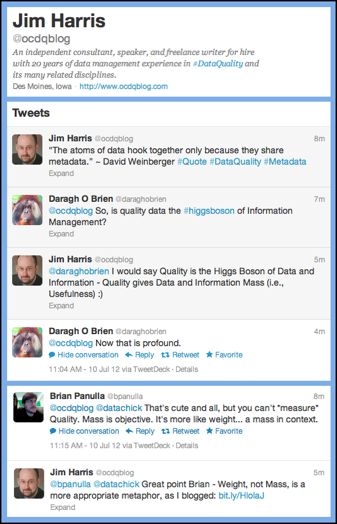Quality is the Higgs Field of Data
/ Recently on Twitter, Daragh O Brien replied to my David Weinberger quote “The atoms of data hook together only because they share metadata,” by asking “So, is Quality Data the Higgs Boson of Information Management?”
Recently on Twitter, Daragh O Brien replied to my David Weinberger quote “The atoms of data hook together only because they share metadata,” by asking “So, is Quality Data the Higgs Boson of Information Management?”
I responded that Quality is the Higgs Boson of Data and Information since Quality gives Data and Information their Mass (i.e., their Usefulness).
“Now that is profound,” Daragh replied.
“That’s cute and all,” Brian Panulla interjected, “but you can’t measure Quality. Mass is objective. It’s more like Weight — a mass in context.”
I agreed with Brian’s great point since in a previous post I explained the often misunderstood difference between mass, an intrinsic property of matter based on atomic composition, and weight, a gravitational force acting on matter.
Using these concepts metaphorically, mass is an intrinsic property of data, representing objective data quality, whereas weight is a gravitational force acting on data, thereby representing subjective data quality.
But my previous post didn’t explain where matter theoretically gets its mass, and since this scientific mystery was radiating in the cosmic background of my Twitter banter with Daragh and Brian, I decided to use this post to attempt a brief explanation along the way to yet another data quality analogy.
As you have probably heard by now, big scientific news was recently reported about the discovery of the Higgs Boson, which, since the 1960s, the Standard Model of particle physics has theorized to be the fundamental particle associated with a ubiquitous quantum field (referred to as the Higgs Field) that gives all matter its mass by interacting with the particles that make up atoms and weighing them down. This is foundational to our understanding of the universe because without something to give mass to the basic building blocks of matter, everything would behave the same way as the intrinsically mass-less photons of light behave, floating freely and not combining with other particles. Therefore, without mass, ordinary matter, as we know it, would not exist.
Ping-Pong Balls and Maple Syrup
I like the Higgs Field explanation provided by Brian Cox and Jeff Forshaw. “Imagine you are blindfolded, holding a ping-pong ball by a thread. Jerk the string and you will conclude that something with not much mass is on the end of it. Now suppose that instead of bobbing freely, the ping-pong ball is immersed in thick maple syrup. This time if you jerk the thread you will encounter more resistance, and you might reasonably presume that the thing on the end of the thread is much heavier than a ping-pong ball. It is as if the ball is heavier because it gets dragged back by the syrup.”
“Now imagine a sort of cosmic maple syrup that pervades the whole of space. Every nook and cranny is filled with it, and it is so pervasive that we do not even know it is there. In a sense, it provides the backdrop to everything that happens.”
Mass is therefore generated as a result of an interaction between the ping-pong balls (i.e., atomic particles) and the maple syrup (i.e, the Higgs Field). However, although the Higgs Field is pervasive, it is also variable and selective, since some particles are affected by the Higgs Field more than others, and photons pass through it unimpeded, thereby remaining mass-less particles.
Quality — Data Gets Higgy with It
Now that I have vastly oversimplified the Higgs Field, let me Get Higgy with It by attempting an analogy for data quality based on the Higgs Field. As I do, please remember the wise words of Karen Lopez: “All analogies are perfectly imperfect.”
Quality provides the backdrop to everything that happens when we use data. Data in the wild, independent from use, is as carefree as the mass-less photon whizzing around at the speed of light, like a ping-pong ball bouncing along without a trace of maple syrup on it. But once we interact with data using our sticky-maple-syrup-covered fingers, data begins to slow down, begins to feel the effects of our use. We give data mass so that it can become the basic building blocks of what matters to us.
Some data is affected more by our use than others. The more subjective our use, the more we weigh data down. The more objective our use, the less we weigh data down. Sometimes, we drag data down deep into the maple syrup, covering data up with an application layer, or bottling data into silos. Other times, we keep data in the shallow end of the molasses swimming pool.
Quality is the Higgs Field of Data. As users of data, we are the Higgs Bosons — we are the fundamental particles associated with a ubiquitous data quality field. By using data, we give data its quality. The quality of data can not be separated from its use any more than the particles of the universe can be separated from the Higgs Field.
The closest data equivalent of a photon, a ping-pong ball particle that doesn’t get stuck in the maple syrup of the Higgs Field, is Open Data, which doesn’t get stuck within silos, but is instead data freely shared without the sticky quality residue of our use.
Related Posts
Our Increasingly Data-Constructed World
What is Weighing Down your Data?
Data Myopia and Business Relativity
Are Applications the La Brea Tar Pits for Data?
Sometimes it’s Okay to be Shallow


